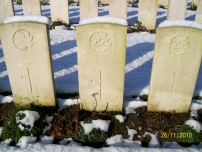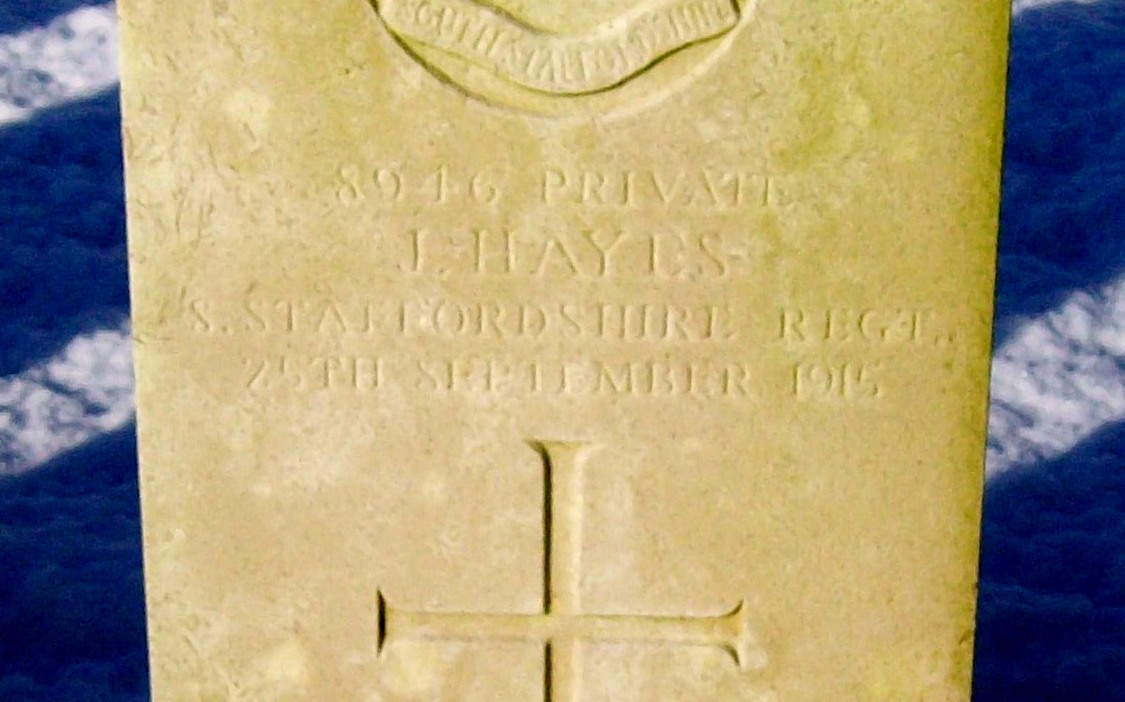| First Name: | James | Last Name: | HAYES | |
|---|---|---|---|---|
| Date of Death: | 25/09/1915 | Lived/Born In: | Spitalfields | |
| Rank: | Private | Unit: | South Staffordshire2 | |
| Memorial Site: | Spitalfields, Christ Church | |||
Current Information:
Born-Spitalfields
Cabaret-Rouge British Cemetery, Souchez, France
The Battle of Loos, fought by the British Army from 25th September, 1915 through to 13th October was conducted along a six-and-a-half-mile front running north from the mining village of Loos on the outskirts of Lens in Northern France. It was the largest offensive carried out by the British so far in the war. The opening day involved at attack by six divisions, with others entering the fray as it progressed and it was part of a much wider offensive with the French launching their own attacks in Champagne and at Vimy. It was the first time that the British used gas during the war, despite their condemnation of the Germans for doing the same in April 1915. There were some encouraging results on the first day but no major breakthrough was achieved and in the successive days the offensive became mired in trench warfare. By mid-October the battle had petered out with the British having suffered over 60,000 casualties during its course. On 25 September, 1915 2nd Division attacked, with all three brigades, on a 3500 yard frontage astride the La Bassee canal with the task of forming a defensive flank facing north-east. 19 Brigade and 6 Brigade attacked between the Vermelles -La Bassee railway and the canal. Their objective was to advance through Auchy and the Railway Triangle to the railway line between Haisnes and the canal and convert Canal Alley into a fire trench. No-man’s-land was less than 100 yards wide and contained a number of mine craters. Vesuvius and Etna, the two largest, had 8 feet high lips, concealing large parts of opposing lines from each other. The Germans had more men here than anywhere else and they had converted their support trench into their main fire trench and evacuated their front trench after levelling the parapet. This gave them a number of advantages. Firstly they had more time to man the defences by adding 100 yards to no-man’s-land, secondly a better field of fire and thirdly an escape from the worst of the bombardment. The brick stacks to the south of the canal concealed concrete machine gun nests with shell proof dug-outs beneath them. To add to their woes of the British, the gas did not do its job on this section of the line. It blew back over the British lines causing many casualties. 6 Brigade attacked just south of the canal with 1st Liverpool (Kings) and 2nd South Staffordshire. Despite the gas officers warning, Divisional HQ insisted the gas was turned on and an unfavourable wind caused a dense cloud to linger over the British line. 130 of 2nd South Staffordshire were incapacitated and unable to fight. 1st Liverpool (Kings) got as far as the German front line where they found two belts of uncut wire. A message was relayed back to Battalion HQ not to send more men. Two mines were blown under the German front line in front of 2nd South Staffordshire but these had little effect as the Germans had retired to their support trench. The left company of 2nd South Staffordshire got right up to the wire of Embankment Redoubt. No other battalions of 6 Brigade were used but inevitably they all suffered some casualties from the artillery action. At 9am a fresh artillery bombardment was ordered for half an hour but because the German defences were still intact, no further infantry attacks were made. |
||||
Other Photos: |
||||
| « Back to Search Results | ||||
| If you think any of the information shown here is incorrect, Click Here to submit your amends and comments | ||||





